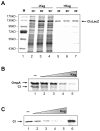An unexpected type of ribosomes induced by kasugamycin: a look into ancestral times of protein synthesis?
- PMID: 19187763
- PMCID: PMC2967816
- DOI: 10.1016/j.molcel.2008.12.014
An unexpected type of ribosomes induced by kasugamycin: a look into ancestral times of protein synthesis?
Abstract
Translation of leaderless mRNAs, lacking ribosomal recruitment signals other than the 5'-terminal AUG-initiating codon, occurs in all three domains of life. Contemporary leaderless mRNAs may therefore be viewed as molecular fossils resembling ancestral mRNAs. Here, we analyzed the phenomenon of sustained translation of a leaderless mRNA in the presence of the antibiotic kasugamycin. Unexpected from the known in vitro effects of the drug, kasugamycin induced the formation of stable approximately 61S ribosomes in vivo, which were proficient in selectively translating leaderless mRNA. 61S particles are devoid of more than six proteins of the small subunit, including the functionally important proteins S1 and S12. The lack of these proteins could be reconciled with structural changes in the 16S rRNA. These studies provide in vivo evidence for the functionality of ribosomes devoid of multiple proteins and shed light on the evolutionary history of ribosomes.
Figures







Comment in
-
Less is more for leaderless mRNA translation.Mol Cell. 2009 Jan 30;33(2):141-2. doi: 10.1016/j.molcel.2009.01.006. Mol Cell. 2009. PMID: 19187755
Similar articles
-
Differential inhibition of 30S and 70S translation initiation complexes on leaderless mRNA by kasugamycin.Biochem Biophys Res Commun. 2002 Oct 4;297(4):1021-1026. doi: 10.1016/s0006-291x(02)02333-1. Biochem Biophys Res Commun. 2002. PMID: 12359258
-
Selective translation of leaderless mRNAs by specialized ribosomes generated by MazF in Escherichia coli.Cell. 2011 Sep 30;147(1):147-57. doi: 10.1016/j.cell.2011.07.047. Epub 2011 Sep 22. Cell. 2011. PMID: 21944167 Free PMC article.
-
Trapping the ribosome to control gene expression.Cell. 2007 Sep 21;130(6):983-5. doi: 10.1016/j.cell.2007.09.002. Cell. 2007. PMID: 17889642
-
Leaderless mRNAs in bacteria: surprises in ribosomal recruitment and translational control.Mol Microbiol. 2002 Jan;43(1):239-46. doi: 10.1046/j.1365-2958.2002.02739.x. Mol Microbiol. 2002. PMID: 11849551 Review.
-
Structure and function of 10Sa RNA: trans-translation system.Biochimie. 1996;78(11-12):985-91. doi: 10.1016/s0300-9084(97)86721-1. Biochimie. 1996. PMID: 9150876 Review.
Cited by
-
Synonymous Mutations in rpsT Lead to Ribosomal Assembly Defects That Can Be Compensated by Mutations in fis and rpoA.Front Microbiol. 2020 Mar 6;11:340. doi: 10.3389/fmicb.2020.00340. eCollection 2020. Front Microbiol. 2020. PMID: 32210939 Free PMC article.
-
The Up-Regulation of Ribosomal Proteins Further Regulates Protein Expression Profile in Female Schistosoma japonicum after Pairing.PLoS One. 2015 Jun 12;10(6):e0129626. doi: 10.1371/journal.pone.0129626. eCollection 2015. PLoS One. 2015. PMID: 26070205 Free PMC article.
-
Structural basis for the methylation of G1405 in 16S rRNA by aminoglycoside resistance methyltransferase Sgm from an antibiotic producer: a diversity of active sites in m7G methyltransferases.Nucleic Acids Res. 2010 Jul;38(12):4120-32. doi: 10.1093/nar/gkq122. Epub 2010 Mar 1. Nucleic Acids Res. 2010. PMID: 20194115 Free PMC article.
-
Pseudouridine Synthase RsuA Captures an Assembly Intermediate that Is Stabilized by Ribosomal Protein S17.Biomolecules. 2020 May 30;10(6):841. doi: 10.3390/biom10060841. Biomolecules. 2020. PMID: 32486254 Free PMC article.
-
Linezolid-dependent function and structure adaptation of ribosomes in a Staphylococcus epidermidis strain exhibiting linezolid dependence.Antimicrob Agents Chemother. 2014 Aug;58(8):4651-6. doi: 10.1128/AAC.02835-14. Epub 2014 Jun 2. Antimicrob Agents Chemother. 2014. PMID: 24890589 Free PMC article.
References
-
- Belanger F, Gagnon MG, Steinberg SV, Cunningham PR, Brakier-Gingras L. Study of the functional interaction of the 900 Tetraloop of 16S ribosomal RNA with helix 24 within the bacterial ribosome. J. Mol. Bio.l. 2004;338:683–693. - PubMed
-
- Blattner FR, Plunkett G, 3rd, Bloch CA, Perna NT, Burland V, Riley M, Collado-Vides J, Glasner JD, Rode CK, Mayhew GF, et al. The complete genome sequence of Escherichia coli K-12. Science. 1997;277:1453–1474. - PubMed
Publication types
MeSH terms
Substances
Grants and funding
LinkOut - more resources
Full Text Sources
Other Literature Sources
Medical
Molecular Biology Databases

